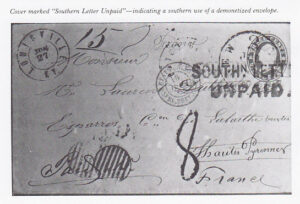Stamps monitor history; they are not issued in a vacuum. In its broadest sense, postal history is history. Throughout the early part of the nineteenth century great tensions between the North and the South, over economic matters and over slavery, culminated in the secession from the United States of the state of South Carolina on December 20, 1860, and at Mississippi, Florida, Alabama, Georgia, Louisiana, and Texas not long after.. by February 4, 1861, the Confederate States of America had been organized and Jefferson Davis was elected President on February 9, 1861. As the North and South prepared for war, the North began to shut down the post offices of the South. The southern Postmaster General, John Reagan, encouraged the North in doing this, and instructed his postmasters to make their final accounts to the United States Post Office by April 30, 1861. Reagan specifically mentioned that all unsold stamps were to be returned and all monies owed to the North were to be paid. The South had hoped to be able to sever itself from the Union without conflict, and Reagan’s order was issued as if the United States Post Office was a long-time contractor with whom the South would no longer be doing business. Many of the southern postmasters complied; but as his order was drafted in early April, before Sumter, the extent of the bitterness that was to arise between North and South was not foreseen. Because of this animosity, most postmasters from the South never made their final accounting with the United States Post Office, and some quantities of United States stamps were found in southern post offices after the war.

But the North never expected a proper accounting from the Confederate States. By June, the United States had ordered new stamps, and in August of 1861, a letter went out to the majority of northern post offices with new stamps, explaining that postmasters were to exchange the new stamps for any of the older ones that postal customers might bring in. All old stamps were to be returned so that they could be destroyed; thereafter they were demonetized, or shorn of their value. The North was afraid that the great mass of old stamps in the South would make their way back north, where they could be sold surreptitiously for hard currency to help the South finance the war. After late 1861, no stamps issued before 1861 had any postal validity at all. Even today, these stamps (#1-39) are still the only stamps issue by our government that are not recognized as postage. If you so desired, you could use any of the stamps of the valuable 1861 issue forward to post your letters.
